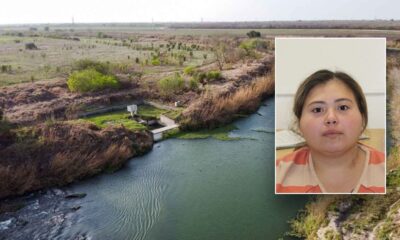Austin, TX
Austin’s Blanton Museum reimagines its grounds as a place for a university campus, city and community

The Blanton Museum of Art’s recently completed $35m renovation of its grounds centres on a reimagined outdoor space that acts as both a gateway and a gathering place. Bringing together three major site-specific installations and led by the architecture firm Snøhetta, the redesign makes a statement that there is a museum here at the University of Texas at Austin (UT)—something that was once easy to overlook when its stately but subdued Spanish Revival buildings blended into the campus.
At one end of the museum’s 200,000 sq. ft footprint is Ellsworth Kelly’s Austin, evoking a secular chapel with its coloured glass windows since its installation there in 2018, and on the other are 12 new towering tulip-like shade structures by Snøhetta. Between them is a panoramic mural by the Cuban American artist Carmen Herrera—her only major public mural commission before she died in 2022 at age 106. Visitors now pass through the mural’s centre as they enter the galleries building, which faces the museum’s administration building across this revamped corridor. Called Verde, que te quiero verde (Green, How I Desire You Green), Herrera’s large-scale panels of green slashed with white recall her 1956 painting Green and White, the pinwheeling pattern now framed by the archways of the loggia that span the Blanton.
“There’s an interesting syncopation between the precise geometries and hard lines of the mural and the curvilinear shapes of the loggia that you see from your approach,” says Vanessa K. Davidson, the Blanton’s curator of Latin American art.
Herrera had previously created only two other (smaller) murals, in 2017 and 2020 for New York City Public Schools. Before focusing primarily on abstract painting, Herrera studied architecture at the University of Havana. She expressed her longtime interest in public work in a letter to the Blanton, writing: “The idea of murals always fascinated me as a lover of architecture; it is a delicate balance to any architect or painter. A space is somehow affected or altered by the altering of its surfaces. I love the challenge and respect the responsibility in the choices that are made.”
VIsitors to the Blanton sit in front of Carmen Herrera’s Verde, que te quiero verde (Green, How I Desire You Green) Photo: Casey Dunn, courtesy the Blanton Museum of Art, Austin, Texas
This thoughtfulness in transforming space extends throughout the renovation, such as Snøhetta’s architectural interventions on the museum buildings themselves with two buoyantly yellow vault shapes echoing the loggia arches, one playfully inverted to frame a staircase that acts as an elevated lookout.
Craig Edward Dykers, a co-founder of Snøhetta, studied at UT and drew on that experience. “We wanted to give the school a strong presence for the future, but we also knew that the campus aesthetic was somewhat conservatively focussed on the past,” he says. “Through our knowledge of the campus, we were able to create a completely contemporary narrative with inventive forms and structure, while still incorporating iconic elements of the past—such as the arches of the nearby buildings.”
This renovation project broke ground in March 2021 and was finished earlier this summer, but the Blanton’s metamorphosis from a small teaching museum to an institution presenting art on an international stage happened gradually over time, with the completion of Kelly’s Austin establishing its first exterior landmark six years ago.
Blanton director Simone Wicha says she has been interested in making the museum as much a community as a cultural space since she took the role in 2011. “Most museums have traditionally had these big, soaring atriums,” she says. “These [Snøhetta] shade structures play a really important practical role, but also provide a sense that you have entered into our atrium, and our atrium is, in a very Austin way, this outdoor space that is not singular to the museum experience. People linger, and it’s part of our civic life.”
Although Herrera became involved later in the process, Wicha wanted to specifically assign the commission to a Latin American artist in order to reflect the museum’s major Latin American art collection. In this way, the new exterior elements are in dialogue with the interior galleries.
Snøhetta’s architectural interventions include a playful elevated outlook onto the courtyard, an echo of the original building’s loggia arches (with Herrera’s mural visible in the back) Photo: Casey Dunn, courtesy the Blanton Museum of Art, Austin, Texas
Wicha also sees the museum as being in a larger conversation with the Texas State Capitol, a building directly connected to the Blanton since the 2022 completion of a green pedestrian mall. Especially at a time when budget cuts and proposed legislation continue to threaten the arts, the museum is in a prominent position to showcase the power of creativity—like how Snøhetta’s native-flora landscapes recognise a future of extreme heat and drought. The eye-catching petal structures funnel rainwater to irrigate the plants below, from the spiky-leafed dwarf palmetto to the green grassy bursts of Cherokee sedge.
“We can make the art museum part of a statement on the importance of the arts,” Wicha says, noting that this has extended to working with faculty to bring students from all disciplines into the museum. “One of the things that is really important to me is that the museum be a place like you would think of a library on the campus, it’s just part of your experience.”
That engagement now extends beyond the museum’s walls in unexpected ways, including a dedicated outdoor gallery for sound. Its debut installation is by Bill Fontana, who made field recordings in the Texas Hill Country, such as of cave bats and local birds. This auditory experience gives the grounds a permeable yet distinct feel. Likewise, an elevated walkway that meanders between historic live oaks at the museum’s southern edge is a path for both visitors and commuters on the adjacent Martin Luther King Jr Boulevard.
“We put a lot of thought into this arrival onto campus and this dual mission,” Wicha says. “There are so many ways that you come to the museum, and we wanted to make sure the moment you walked in, you had an art experience and a beautiful, welcoming, clear understanding of where you were.”

Austin, TX
LD Systems expands Texas Footprint with Austin Location and welcomes ILIOS Productions — TPi

For over two decades, ILIOS Productions has been a key part of the live events community in Austin, TX, transforming spaces and audience experiences with a vast range of lighting and video design, as well as event production services across a diverse client portfolio. Now, with the backing of parent company Clair Global, LD Systems, a Houston-based premier provider of audio, video, and lighting for event production and installed technology solutions, is welcoming ILIOS Productions to the team, marking the group’s fourth location in Texas. ILIOS Productions will now operate under the LD Systems brand.
LD Systems will further resource ILIOS’ existing Austin operation to include additional services such as audio and rigging for live events, as well as integration solutions and services. This addition helps round out LD Systems’ ability to locally serve major metropolitan areas across Texas, including Houston, San Antonio, Dallas-Fort Worth, and Austin and reflects Clair Global’s continued focus on offering global resources while maintaining strong local-market expertise and responsiveness.
ILIOS Productions’ experience spans the concert and festival sector, corporate and activations, and high-end private, philanthropic and charitable events. The company’s commitment to critical event delivery has established trust with major brands including Lollapalooza, SXSW, Austin City Limits, Google, YouTube, the University of Texas System and many more.
Founder, President & Sr Ops Manager of ILIOS Productions, Bryan Azar, said: “After many years of working alongside LD Systems in Austin and beyond, we are delighted to be joining their world-class organisation. This is an exciting new chapter for a bolder future together.”
Zach Boswell, General Manager, ILIOS Productions, added: “We are passionate about the work we do, and the community and business culture found at LD Systems is the ideal next step for our dedicated employees to progress as a united workforce.“
LD Systems co-founder and President, Rob McKinley commented: “We are delighted to amplify our service offerings in Austin with the addition of Bryan and his exceptional team of technology professionals. They have made a significant difference to many Texans with the work they undertake, and LD Systems is proud to welcome both their talent and ethos to the company.”
Building on this momentum, LD Systems also announced plans to expand its San Antonio facility into a new location in January 2026. Together with the addition of ILIOS Productions in Austin, this investment reinforces the organisation’s long-term investment in Texas and its dedication to meeting growing client demand with enhanced capacity and infrastructure.
www.ldsystems.com
Austin, TX
Austin airport one step closer to major expansion that will add 32 new gates

AUSTIN, Texas — Austin-Bergstrom International Airport is one step closer to getting a major makeover after finalizing lease agreements with airlines that will support future renovations, including the addition of 32 new gates.
The airport on Wednesday announced the completion of Airline Use and Lease Agreements and Signatory Cargo Agreements with several major airlines and cargo companies, including Southwest Airlines, Delta Air Lines, United Airlines, American Airlines, Alaska Airlines, FedEx and UPS.
According to a press release from the airport, the use-and-lease agreements allow companies to commit funding to the project through rent and fees “generated under the agreements’ cost-recovery structure, supporting the airport’s ability to deliver projects that expand capacity, strengthen resiliency, and improve the passenger experience.”
The agreements will support the following projects at Austin-Bergstrom over the next 10 years:
- The addition of Concourse B, which will add 26 new gates, including 18 for Southwest Airlines and five with United Airlines.
- Concourse M, adding six new gates, a bus to transport travelers to and from the Barbara Jordan Terminal, new concessions, restrooms and passenger amenities.
- Enhanced seating and amenities, increased space and modernized concessions in Concourse A (home to all international flights). Delta Air Lines will have 15 gates, American Airlines will have nine, Alaska Airlines will have one and there will be eight common-use gates.
- Updates to HVAC systems, electrical system, IT and telecommunications, storm drainage, water quality and de-icing infrastructure.
In a statement, District 2 Councilmember Vanessa Fuentes applauded the future job creation that’s to come out of the project.
“This expansion program represents a tremendous economic opportunity for Austin—not only through the trades and construction jobs created during the buildout, but also through long-term jobs in concessions, airport operations, and airline services after the program is complete,” Fuentes said.
“This agreement reflects years of partnership, thoughtful negotiations, and shared vision with our airline partners. Their commitment provides the financial foundation we need to modernize our facilities, transform customer experience, and build the infrastructure needed to support Central Texas’ continued growth for generations to come. AUS would not be where it is today without the collaboration and investment of our airlines, and we are deeply grateful for their trust and partnership as we shape the future of air travel in Central Texas,” said Ghizlane Badawi, CEO of Austin-Bergstrom International Airport.
The final cost of the project is still under development, but is anticipated to grow from an estimated $4 billion to $5 billion. According to the airport, funding sources include airport cash reserves, airport revenues, bond proceeds and grants from the Federal Aviation Administration.
“No local Austin taxpayer dollars are used to fund the airport’s expansion program,” the release said.
Austin, TX
Black Sheep Coffee Opens First Austin Location, Expanding Its Texas Footprint | What Now Austin

Black Sheep Coffee, the international coffee brand, will celebrate the opening of its first Central Texas location in Downtown Austin with two public events. The new café, located at W 6th St & Guadalupe St, Austin, TX 78701, marks a significant step in the company’s U.S. expansion following strong growth throughout the Dallas–Fort Worth region.
A public ribbon-cutting ceremony, hosted in partnership with the Austin Chamber of Commerce, will take place on Thursday, January 15 from 12:00 p.m. – 2:00 p.m., welcoming community members, local leaders, and partners into the space. During the event, guests can enjoy half-price lattes, including coffee and matcha drinks.
On Saturday, January 17, Black Sheep Coffee will officially celebrate their grand opening with a Sips & Beats event from 11:00 a.m. to 2:00 p.m., featuring live vinyl set by DJ Foxxy Brown, signature menu tastings, and half-price lattes throughout the event. Continuing the celebration, the store will also offer a 50% discount to International Half Marathon medal holders on Sunday, January 18, welcoming runners and spectators to refuel post-race.
Designed to reflect Austin’s creative identity, the location features custom graffiti artwork inspired by the city’s street art scene and the energy of Downtown. The new outpost will serve Black Sheep Coffee’s complete menu, including its 100% specialty-grade Robusta coffee, ceremonial-grade matcha, smoothies, pastries, Norwegian waffles, curated food offerings, and two bakery variations created exclusively for the Austin store. Additional limited-time items will debut later in January as part of the brand’s functional health product refresh.
“Austin has long been on our radar for its passionate community and standout coffee culture,” said Eirik Holth, co-founder of Black Sheep Coffee in a statement. “We’re excited to become part of that fabric and bring something new to Downtown. With several U.S. locations in the pipeline, Austin marks a major milestone in our next chapter of growth.”
Black Sheep Coffee chose Austin for its strong alignment with the brand’s ethos and its reputation as a city that celebrates individuality and creativity. The opening also reinforces the company’s long-term commitment to Texas, with several additional locations planned statewide for 2026.
The Austin café will be open Sunday through Thursday from 6:00 a.m. to 8:00 p.m. and Friday and Saturday from 6:00 a.m. to 9:00 p.m. For more information, visit BlackSheepCoffee.us.
-

 Detroit, MI5 days ago
Detroit, MI5 days ago2 hospitalized after shooting on Lodge Freeway in Detroit
-

 Dallas, TX3 days ago
Dallas, TX3 days agoDefensive coordinator candidates who could improve Cowboys’ brutal secondary in 2026
-

 Technology2 days ago
Technology2 days agoPower bank feature creep is out of control
-

 Health4 days ago
Health4 days agoViral New Year reset routine is helping people adopt healthier habits
-

 Nebraska1 day ago
Nebraska1 day agoOregon State LB transfer Dexter Foster commits to Nebraska
-

 Politics4 days ago
Politics4 days agoDan Bongino officially leaves FBI deputy director role after less than a year, returns to ‘civilian life’
-

 Nebraska2 days ago
Nebraska2 days agoNebraska-based pizza chain Godfather’s Pizza is set to open a new location in Queen Creek
-

 Louisiana3 days ago
Louisiana3 days agoInternet company started with an antenna in a tree. Now it’s leading Louisiana’s broadband push.
























